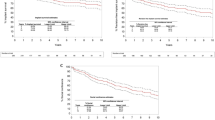Abstract
Purpose
Artificial urinary sphincter (AUS) implantation in female patients results in high satisfaction rates and high functional outcomes, but implantation can be challenging and explantation of the device is fairly common. The objective of this study was to review outcomes after AUS explantation in women.
Methods
This is a retrospective, monocentric study of all women who underwent open or laparoscopic AUS implantation between November 1994 and July 2019, and patients with AUS explantation were included. Management after AUS explantation using descriptive analysis was assessed.
Results
Over a span of 26 years, 111 women had an AUS implanted by a single surgeon. Of these surgeries, 35 explantations in 29 patients were later required: 20 initial AUSs, nine revised AUSs and six reimplanted AUS (rAUSs). The median time to explantation was 15.5 month (± 0.55). After explantation, 13 rAUSs in 10 patients were successful and two attempts failed. The median time between explantation and rAUS was 8 months (± 0.95). At the last follow-up, five patients still had their rAUS and six rAUSs had required explantation after a median time of 6.5 months (± 0.65).
Surgery was still possible for 12 patients who did not have a rAUS: three cystectomies, one bladder neck closure with continent urinary diversion, and six mid-urethral slings or adjustable continence therapy balloon implantations. Among the 23 patients who did not need a cystectomy or a bladder neck closure with continent urinary diversion, four were completely dry (17.4%), 11 were improved (47.8%), and eight (34.8%) experienced unchanged incontinence with the post-explantation management. Limitations include retrospective design, heterogeneous management over time and a relatively small population of patients in our cohort.
Conclusion
Reimplantation of an AUS after an explantation seems feasible after at least 6 months. However, the surgery will be more difficult and satisfaction is not guaranteed. Multicenter databases should be created to help surgeons and patients decide on appropriate management strategies after explantation of an AUS.
Similar content being viewed by others
References
Lucas MG, Bosch RJL, Burkhard FC et al (2012) EAU guidelines on surgical treatment of urinary incontinence. EurUrol 62:1118–1129. https://doi.org/10.1016/j.eururo.2012.09.023
Groen J, Pannek J, Castro Diaz D et al (2016) Summary of European Association of Urology (EAU) guidelines on neuro-urology. EurUrol 69:324–333. https://doi.org/10.1016/j.eururo.2015.07.071
Peyronnet B, O’Connor E, Khavari R et al (2018) AMS-800 Artificial urinary sphincter in female patients with stress urinary incontinence: A systematic review. NeurourolUrodyn. https://doi.org/10.1002/nau.23833
Phé V, Benadiba S, Rouprêt M et al (2014) Long-term functional outcomes after artificial urinary sphincter implantation in women with stress urinary incontinence. BJU Int 113:961–967. https://doi.org/10.1111/bju.12360
Reus CR, Phé V, Dechartres A et al (2018) Performance and safety of the artificial urinary sphincter (AMS 800) for non-neurogenic women with urinary incontinence secondary to intrinsic sphincter deficiency: a systematic review. EurUrol Focus. https://doi.org/10.1016/j.euf.2018.10.009
Tricard T, Jochum F, Bergerat S et al (2019) Outcomes of open artificial urinary sphincter in women with stress urinary incontinence: long-term follow up. TherAdvUrol 11:1756287219874676. https://doi.org/10.1177/1756287219874676
Ferreira C, Brychaert P-E, Menard J, Mandron E (2017) Laparoscopic implantation of artificial urinary sphincter in women with intrinsic sphincter deficiency: mid-term outcomes. Int J Urol 24:308–313. https://doi.org/10.1111/iju.13296
Tricard T, Schirmann A, Munier P et al (2020) Outcomes of artificial urinary sphincter in female with neurological stress urinary incontinence: a long-term follow-up. World J Urol. https://doi.org/10.1007/s00345-020-03105-2
Fournier G, Callerot P, Thoulouzan M et al (2014) Robotic-assisted laparoscopic implantation of artificial urinary sphincter in women with intrinsic sphincter deficiency incontinence: initial results. Urology 84:1094–1098. https://doi.org/10.1016/j.urology.2014.07.013
Peyronnet B, Capon G, Belas O et al (2018) Robot-assisted AMS-800 artificial urinary sphincter bladder neck implantation in female patients with stress urinary incontinence. EurUrol. https://doi.org/10.1016/j.eururo.2018.07.036
Peyronnet B, Hascoet J, Scailteux L-M et al (2018) The changing face of artificial urinary sphincter use in france: the future is female. EurUrol Focus. https://doi.org/10.1016/j.euf.2018.12.005
Light JK, Scott FB (1985) Management of urinary incontinence in women with the artificial urinary sphincter. J Urol 134:476–478
Schroeder A, Munier P, Saussine C, Tricard T (2021) Outcomes of laparoscopic artificial urinary sphincter in women with stress urinary incontinence: mid-term evaluation. World J Urol. https://doi.org/10.1007/s00345-020-03527-y
Funding
None.
Author information
Authors and Affiliations
Contributions
TT: Project development, data collection, manuscript writing. IAH: Data collection, Manuscript reviewing. PM: manuscript reviewing. AS: Data collection. SC: project development.
Corresponding author
Ethics declarations
Conflicts of interest
The authors have no financial or proprietary interests in any material discussed in this article.
Research involving Human Participants and/or Animals
This retrospective chart review study involving human participants was in accordance with the ethical standards of the institutional and national research committee and with the 1964 Helsinki Declaration and its later amendments or comparable ethical standards.
Informed consent
Informed consent was obtained from all individual participants included in the study.
Additional information
Publisher's Note
Springer Nature remains neutral with regard to jurisdictional claims in published maps and institutional affiliations.
Rights and permissions
About this article
Cite this article
Tricard, T., Al Hashimi, I., Schroeder, A. et al. Real-life outcomes after artificial urinary sphincter explantation in women suffering from severe stress incontinence. World J Urol 39, 3891–3896 (2021). https://doi.org/10.1007/s00345-021-03672-y
Received:
Accepted:
Published:
Issue Date:
DOI: https://doi.org/10.1007/s00345-021-03672-y




